Application of Self-Compacting Steel Fiber Reinforced Concrete for Pervious Frames Used for River Revetment
Abstract
1. Introduction
2. Materials and Methods
2.1. Raw Materials
2.2. Mix Proportion of Self-Compacting SFRC
2.3. Manufacture of Pervious Frames
2.3.1. Composite Steel Mold
2.3.2. Casting Process
2.4. Test Method of Loading Test on Pervious Frames
3. Results and Discussion
3.1. Workability of Fresh Self-Compacting SFRC
3.2. Mechanical Properties of Self-Compacting SFRC
3.3. Failure Characteristics of Pervious Frames
3.4. Strains
3.5. Limit Loads of Pervious Frames
4. Engineering Application
5. Conclusions
- (1)
- The mix proportion, the workability of fresh mix, and the mechanical properties of self-compacting SFRC used for producing the pervious frames were experimentally studied with the change of the steel fiber content. The rational volume fraction of steel fiber was determined as 0.8% considering the requirement of this special application.
- (2)
- With the good workability of self-compacting SFRC, the casting process of SFRC from an inclined rod to other inclined rods, and finally to horizontal rods leads to a conducive distribution of steel fiber along the length of the rods. This improves the mechanical properties of the pervious frame subjected to tensile forces during lifting and stacking.
- (3)
- During lifting, the frame at the bottom layer is more likely to be damaged than that at the upper layer, which may be broken on the inclined rods. During stacking, the upper-layer frame is more prone to cracking and failure than the first-layer frame, but not including breaks in the rod. The frames allow six layers lifted together and nineteen layers stacked without any damage.
- (4)
- The self-compacting SFRC pervious frames have been successfully applied in a river revetment project. This is a new engineering application for self-compacting SFRC.
Author Contributions
Funding
Institutional Review Board Statement
Informed Consent Statement
Data Availability Statement
Conflicts of Interest
References
- Wang, N.H.; Zhang, W.J.; Wang, B. Application of a new technology of bank protection employing tetrahedron-like penetrating frame groups in Yangtze River. J. Yangtze River Sci. Res. Inst. 1999, 2, 12–17. [Google Scholar]
- Xu, G.B.; Zhang, Y.Z. Application of tetrahedron-like concrete penetrating frames in river improvement, bank protection and emergency work. J. Tianjin Univ. 2006, 12, 1465–1469. [Google Scholar]
- Tang, G.X. Improvement of permeable framework production process and analysis of project economic adaptability. Port Waterway Eng. 2014, 12, 201–204. [Google Scholar]
- Jing, W.; Li, T.Z.; Hu, N.; Wang, T. Construction quality control of bank protection by concrete permeable frames of tetrahedron with six sides. Yangtze River 2010, 8, 104–107. [Google Scholar]
- Zhou, G.D.; Gu, Z.H.; Gao, Z.; Tang, T. Hydraulic Characteristics of Tetrahedron-like Penetrating Frame Wake. J. Yangtze River Sci. Res. Inst. 2005, 3, 9–12. [Google Scholar]
- Liu, G. The Experimental Study on Flow Characteristics of Tetrahedron-Like Penetrating Frame and Bank-Protection Application. Master’s Thesis, Hohai University, Nanjing, China, 2006. [Google Scholar]
- Yang, Z.C. Mechanized prefabricated construction technique for monolithic six-side permeable frame. Port Waterway Eng. 2017, 2, 2–4. [Google Scholar]
- Xu, T.C.; Zhang, W.; Tang, Y.; Zhang, Y.S.; Chang, L.H.; Xu, B. Automatic synchronous throwing equipment and technology of tetrahedron-like penetrating frame. Port Waterway Eng. 2020, 4, 169–174. [Google Scholar]
- Ding, X.X.; Zhao, M.L.; Qiu, X.; Wang, Y.P.; Ru, Y.J. The optimization of mix proportion design for SCC: Experimental study and grey relational analysis. Materials 2022, 15, 1305. [Google Scholar] [CrossRef] [PubMed]
- Ding, X.X.; Geng, H.B.; Shi, K.; Song, L.; Li, S.Y.; Liu, G.Y. Study on adaptability of test methods for workability of fresh self-compacting SFRC. Materials 2021, 14, 5312. [Google Scholar] [CrossRef]
- Ding, X.X.; Zhao, M.L.; Zhou, S.Y. Statistical analysis and preliminary study on the mix proportion design of self-compacting steel fiber reinforced concrete. Materials 2019, 12, 637. [Google Scholar] [CrossRef]
- Sobuz, M.H.R.; Saha, A.; Anamika, J.F.; Houda, M.; Azab, M.; Akid, A.S.M.; Rana, M.J. Development of self-compacting concrete incorporating rice husk ash with waste galvanized copper wire fiber. Buildings 2022, 12, 1024. [Google Scholar] [CrossRef]
- Kristyna, H.; Jaromir, L.; Petr, L. Statistical and practical evaluation of the mechanical and fracture properties of steel fibre reinforced concrete. Buildings 2022, 12, 1082. [Google Scholar]
- Ding, X.X.; Li, C.Y.; Zhao, M.L.; Li, J.; Geng, H.B.; Lian, L. Tensile Behavior of self-compacting steel fiber reinforced concrete evaluated by different test methods. Crystals 2021, 11, 251. [Google Scholar] [CrossRef]
- Li, C.Y.; Shang, P.R.; Li, F.L.; Feng, M.; Zhao, S.B. Shrinkage and mechanical properties of self-compacting SFRC with calcium-sulfoaluminate expansive agent. Materials 2020, 13, 588. [Google Scholar] [CrossRef] [PubMed]
- Ding, X.X.; Li, C.Y.; Han, B.; Lu, Y.Z.; Zhao, S.B. Effects of different deformed steel-fibers on preparation and properties of self-compacting SFRC. Constr. Build. Mater. 2018, 168, 471–481. [Google Scholar] [CrossRef]
- Mahakavi, P.; Chithra, R. Impact resistance, microstructures and digital image processing on self-compacting concrete with hooked end and crimped steel fiber. Constr. Build. Mater. 2019, 220, 651–666. [Google Scholar] [CrossRef]
- Zhao, M.L.; Li, J.; Law, D. Effects of flowability on SFRC fibre distribution and properties. Magaz. Concr. Res. 2017, 69, 1043–1054. [Google Scholar] [CrossRef]
- Zhao, M.L.; Li, J.; Xie, Y.M. Effect of vibration time on steel fibre distribution and flexural properties of steel fibre reinforced concrete with different flowability. Case Study Constr. Mater. 2022, 16, e01114. [Google Scholar]
- Vaishnav, K.; Krishna, C.; Madupu, S.; Venkata, S. Evaluation of mechanical and flow properties of crimpled steel fiber in self compacting concrete. Mater. Today Proc. 2021, 45, 4835–4840. [Google Scholar] [CrossRef]
- Abdalla, M.; Afzal, H.K.; Mohammad, N.A.; Nadeem, A.; Seyed, S.; Michal, P.; Neyara, R. Strength and flexural behavior of steel fiber and silica fume incorporated self-compacting concrete. J. Mater. Res. Technol. 2021, 12, 1380–1390. [Google Scholar]
- Abbas, A.A. The Effect of steel fiber on some mechanical properties of self compacting concrete. Am. J. Civ. Eng. 2014, 1, 102–110. [Google Scholar]
- Geng, H.B.; Liao, Y.M.; Feng, M.; Li, X.K. Experimental study on preparation of self-compacting steel fiber reinforced concrete (SFRC) for permeable frame. Yangtze River 2021, 9, 198–202. [Google Scholar]
- Feng, M.; Zhang, T.C.; Geng, H.B.; Li, F.L. Applied research of self-compacting steel fiber reinforced concrete for pervious frames. Yellow River 2021, 6, 50–54. [Google Scholar]
- JG/T472-2015; Steel Fiber Reinforced Concrete. China Standard Press: Beijing, China, 2015.
- JGJ/T283-2012; Technical Specification for Application of Self-compacting Concrete. China Building Industry Press: Beijing, China, 2012.
- CECS13:2009; Standard Test Methods for Fiber Reinforced Concrete. China Planning Press: Beijing, China, 2009.
- Ding, X.X.; Geng, H.B.; Zhao, M.L.; Chen, Z.; Li, J. Synergistic bond behaviors of different deformed steel fibers embedded in mortars wet-sieved from self-compacting SFRC with manufactured sand by using pull-out test. Appl. Sci. 2021, 11, 10144. [Google Scholar] [CrossRef]
- Han, R.; Zhao, S.B.; Qu, F.L. Experimental study on the tensile performance of steel fiber reinforced concrete. China Civ. Eng. J. 2006, 11, 63–67. [Google Scholar]
- GB50010-2010; Code for Design of Concrete Structures. China Building Industry Press: Beijing, China, 2010.
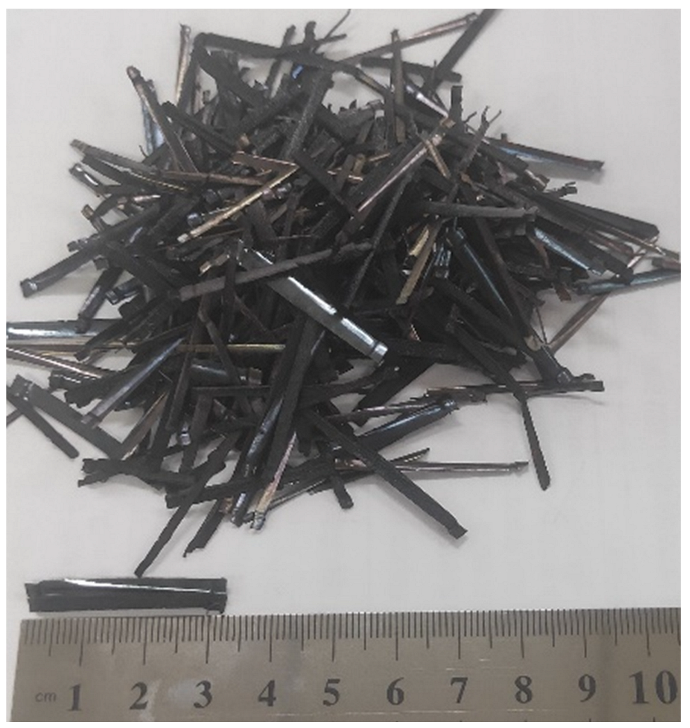
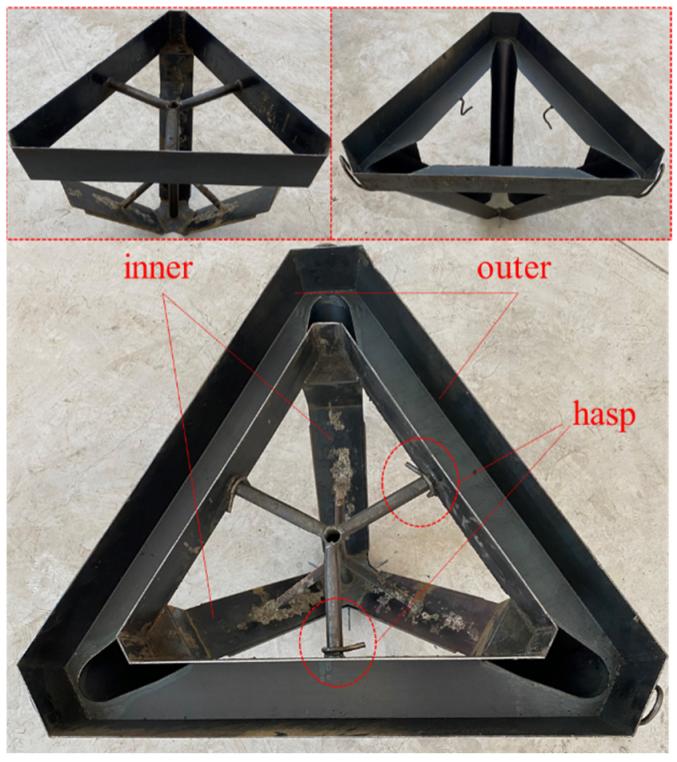
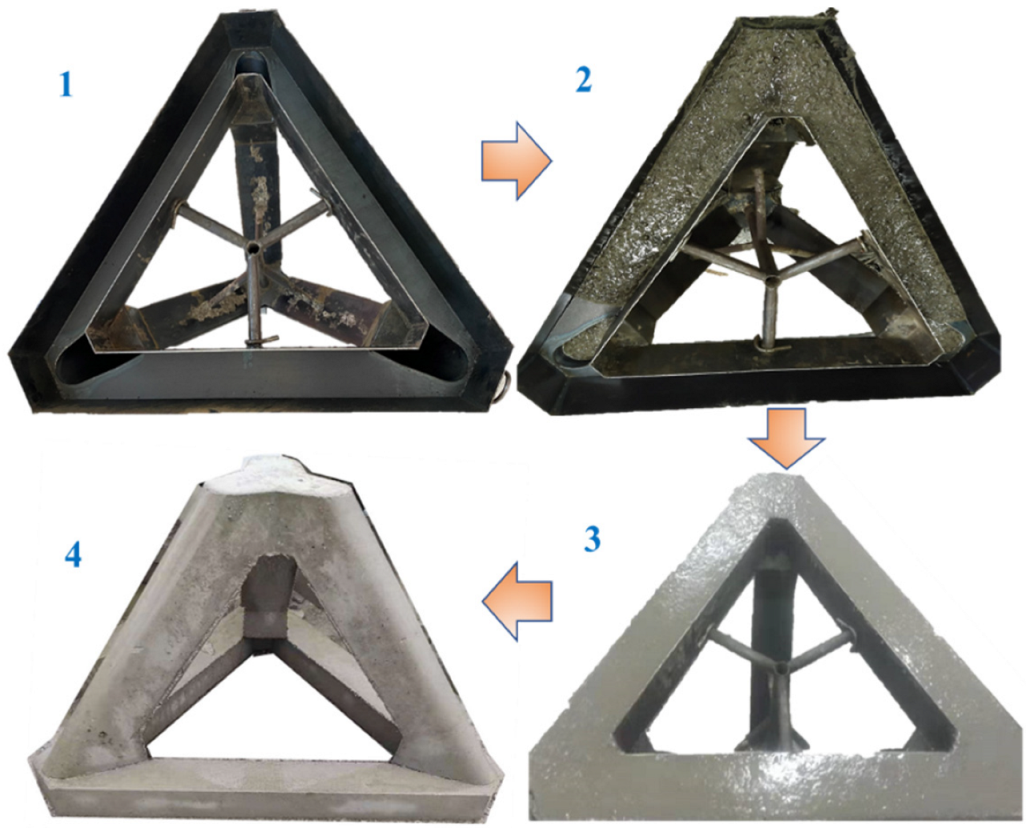


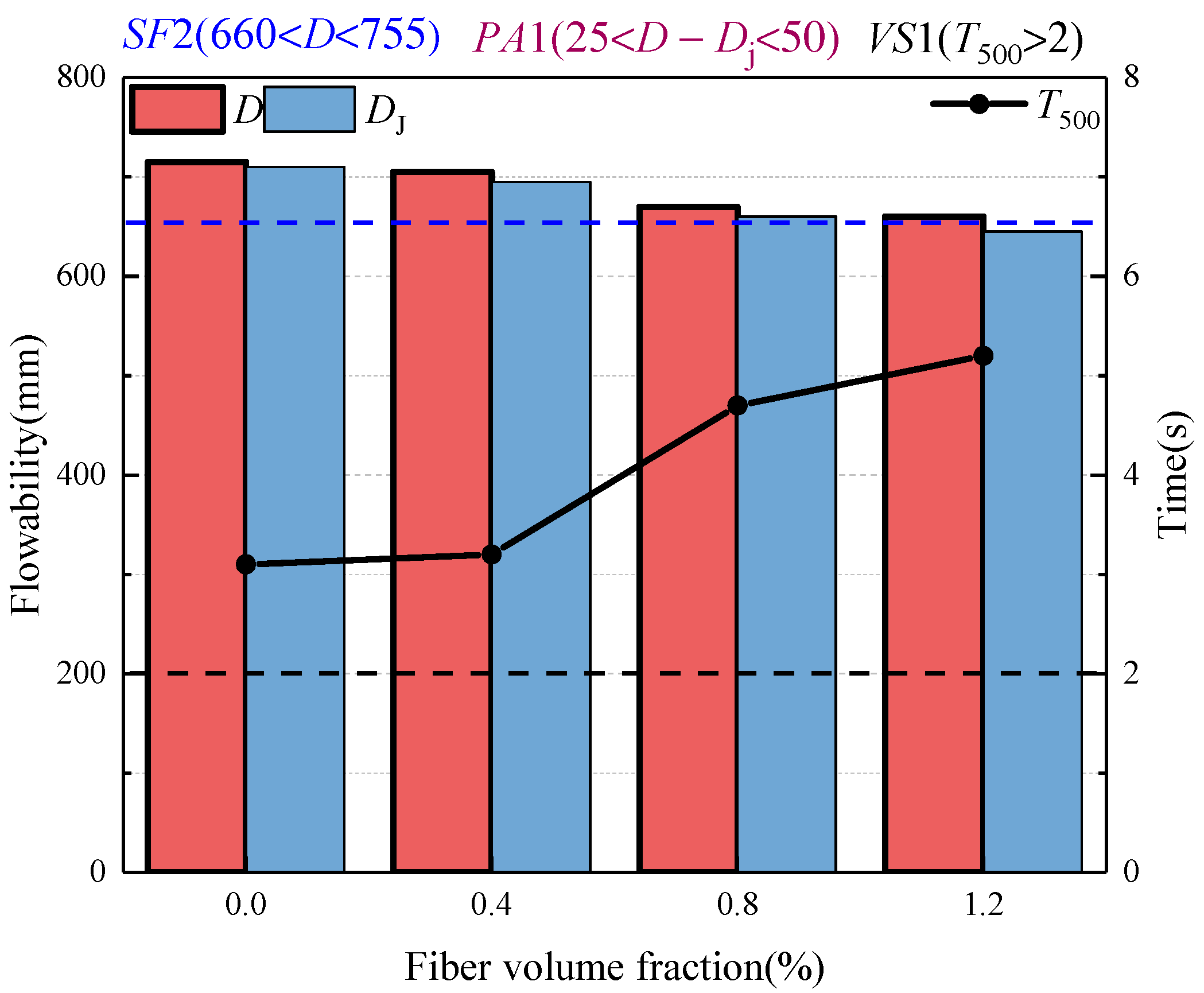
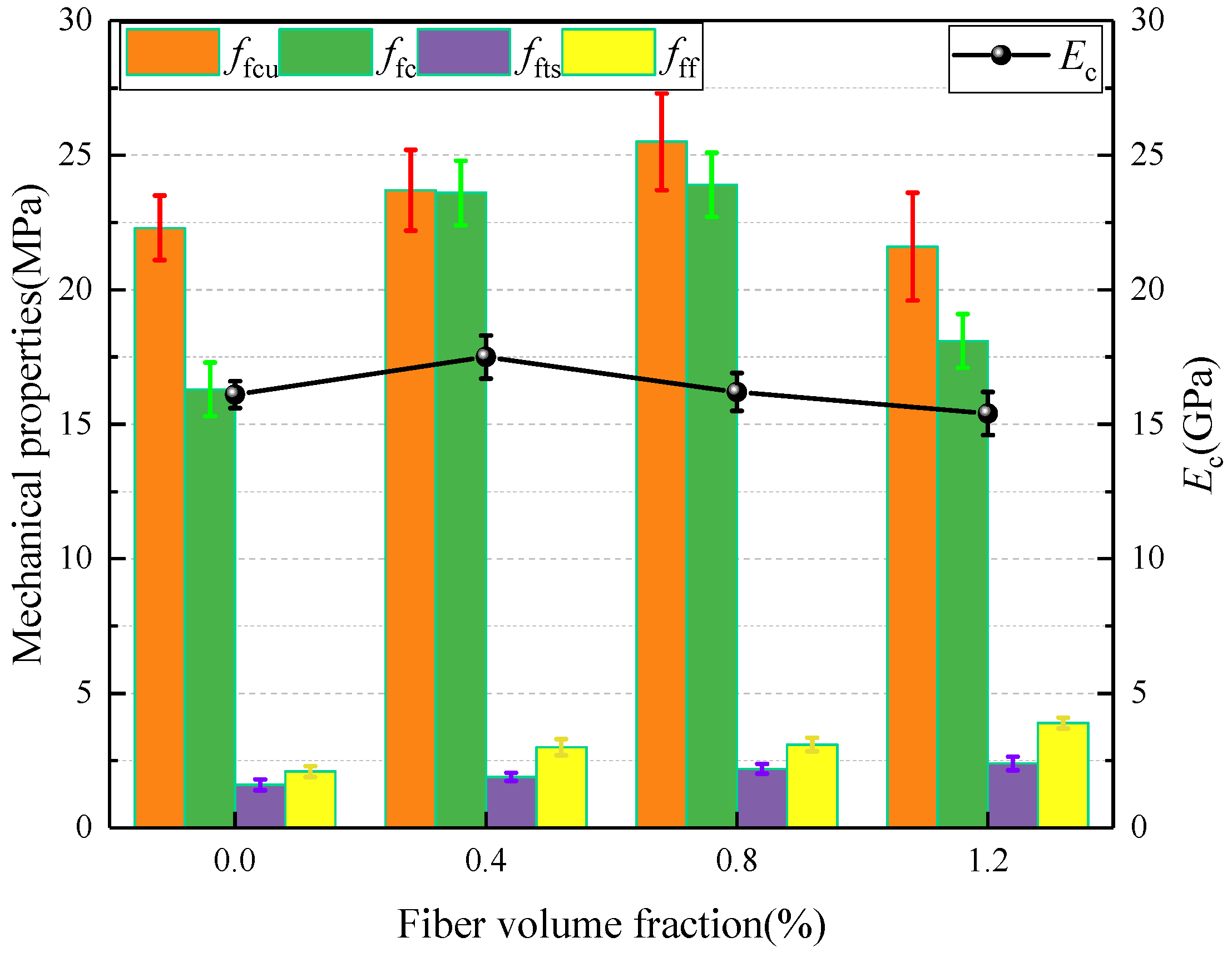
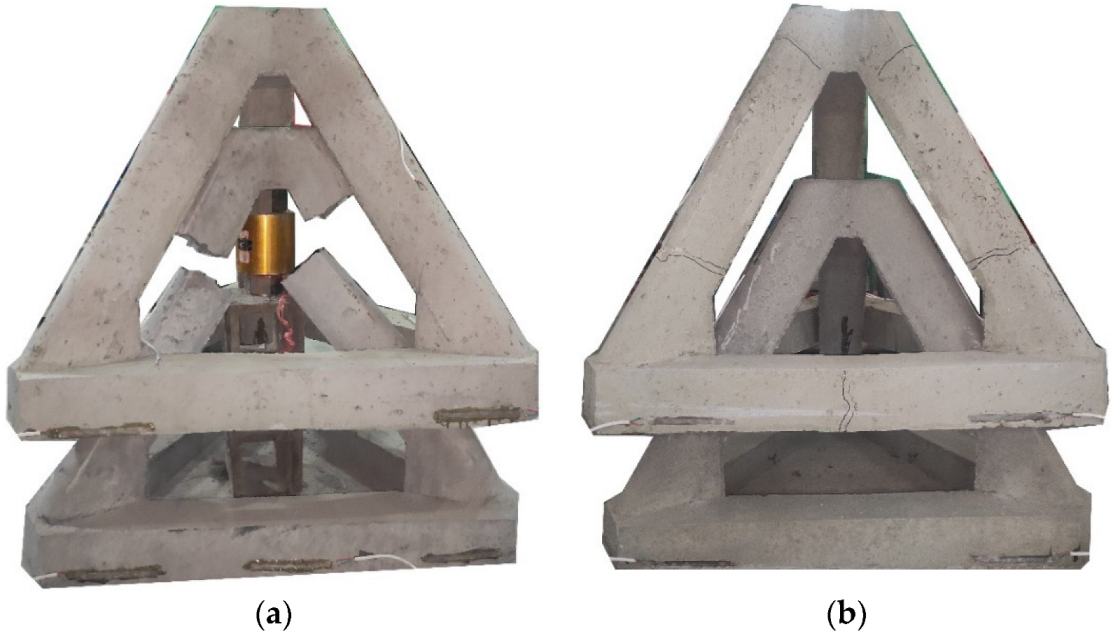

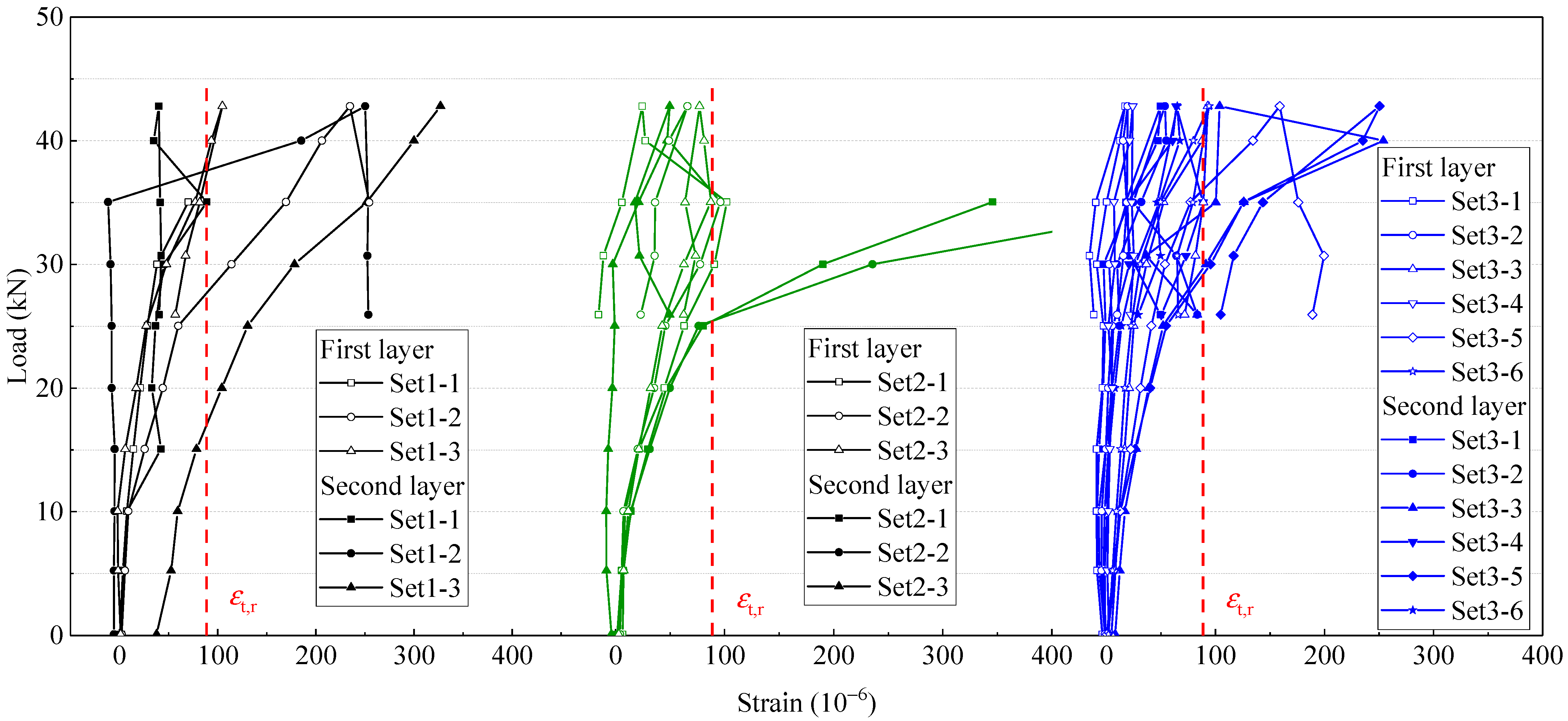
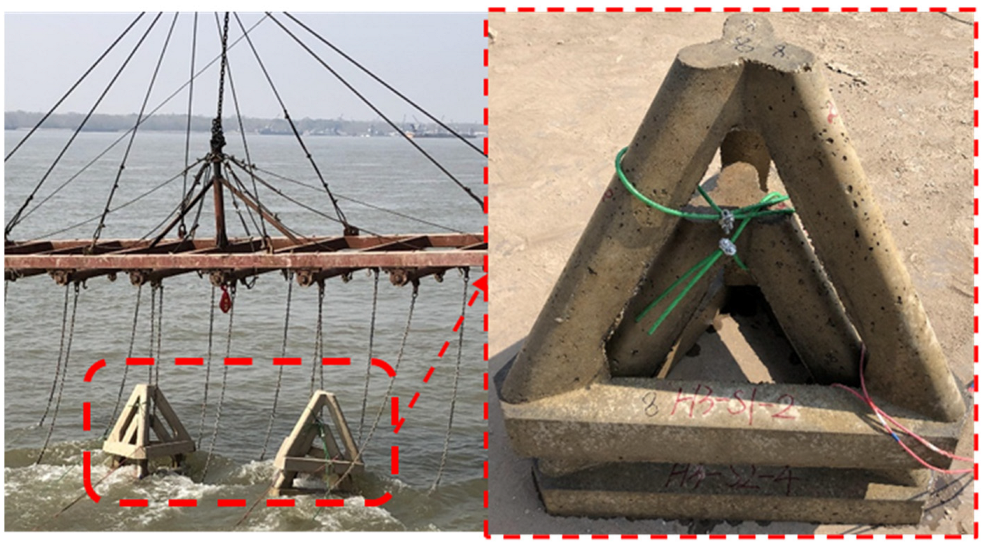
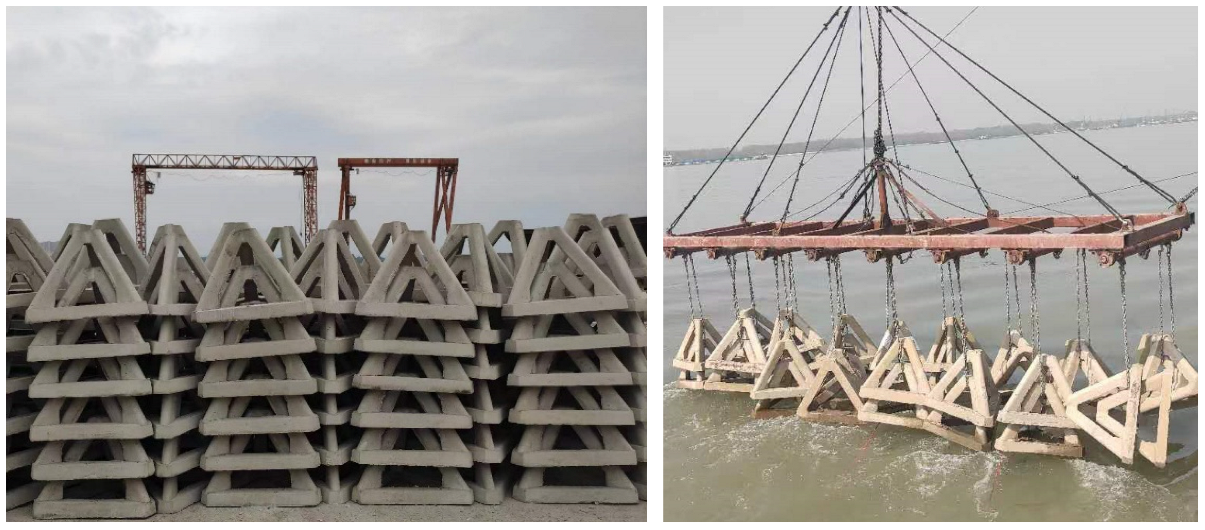
| Density (kg/m³) | Consistency (%) | Setting Time (min) | Triage Residue (%) | Flexural Strength (MPa) | Compressive Strength (MPa) | ||||
|---|---|---|---|---|---|---|---|---|---|
| Initial | Final | 45 μm | 80 μm | 3 d | 28 d | 3 d | 28 d | ||
| 3034 | 30.0 | 290 | 390 | 13.8 | 4.9 | 4.3 | 6.0 | 20.7 | 37.5 |
| % | CaO | SiO2 | Al2O3 | Fe2O3 | SO3 | MgO | Loss |
|---|---|---|---|---|---|---|---|
| Cement | 66.0 | 18.3 | 3.6 | 6.7 | 3.8 | 2.9 | 3.8 |
| Fly ash | 6.6 | 55.9 | 17.3 | 5.9 | 1.9 | 3.8 | 2.6 |
| Aggreagte | Density (kg/m³) | Water Absorption at 24 h (%) | Silt Content (%) | Fineness Modulus | ||
|---|---|---|---|---|---|---|
| Apparent | Bulk | Compacted | ||||
| Crushed limestone | 2713 | 1412 | 1561 | 2.60 | 2.86 | - |
| River sand | 2613 | 1501 | 1601 | 1.33 | 2.74 | 2.77 |
| Mix ID | SCF00 | SCF04 | SCF08 | SCF12 |
|---|---|---|---|---|
| Water to binder ratio w/b | 0.35 | 0.35 | 0.35 | 0.35 |
| Sand ratio βs (%) | 53 | 54 | 55 | 56 |
| Fly ash ratio βf (%) | 20 | 20 | 20 | 20 |
| Water reducer ratio βa (%) | 1.4 | 1.4 | 1.4 | 1.5 |
| Volume fraction of steel fiber vf (%) | 0 | 0.4 | 0.8 | 1.2 |
| Water (kg/m3) | 195.9 | 195.9 | 195.9 | 195.9 |
| Cement (kg/m3) | 447.8 | 447.8 | 447.8 | 447.8 |
| Fly ash (kg/m3) | 112.0 | 112.0 | 112.0 | 112.0 |
| Sand (kg/m3) | 795.4 | 806.1 | 816.8 | 827.5 |
| Gravel (kg/m3) | 705.4 | 683.5 | 661.5 | 639.6 |
| Steel fiber (kg/m3) | 0 | 31.4 | 62.8 | 94.2 |
| Water reducer (kg/m3) | 7.8 | 7.8 | 7.8 | 8.4 |
Publisher’s Note: MDPI stays neutral with regard to jurisdictional claims in published maps and institutional affiliations. |
© 2022 by the authors. Licensee MDPI, Basel, Switzerland. This article is an open access article distributed under the terms and conditions of the Creative Commons Attribution (CC BY) license (https://creativecommons.org/licenses/by/4.0/).
Share and Cite
Geng, H.; Ding, X.; Du, H.; Shi, J.; Li, C.; Li, X. Application of Self-Compacting Steel Fiber Reinforced Concrete for Pervious Frames Used for River Revetment. Appl. Sci. 2022, 12, 10457. https://doi.org/10.3390/app122010457
Geng H, Ding X, Du H, Shi J, Li C, Li X. Application of Self-Compacting Steel Fiber Reinforced Concrete for Pervious Frames Used for River Revetment. Applied Sciences. 2022; 12(20):10457. https://doi.org/10.3390/app122010457
Chicago/Turabian StyleGeng, Haibin, Xinxin Ding, Hao Du, Jiaxin Shi, Changyong Li, and Xiaoke Li. 2022. "Application of Self-Compacting Steel Fiber Reinforced Concrete for Pervious Frames Used for River Revetment" Applied Sciences 12, no. 20: 10457. https://doi.org/10.3390/app122010457
APA StyleGeng, H., Ding, X., Du, H., Shi, J., Li, C., & Li, X. (2022). Application of Self-Compacting Steel Fiber Reinforced Concrete for Pervious Frames Used for River Revetment. Applied Sciences, 12(20), 10457. https://doi.org/10.3390/app122010457






